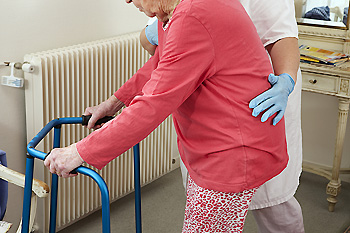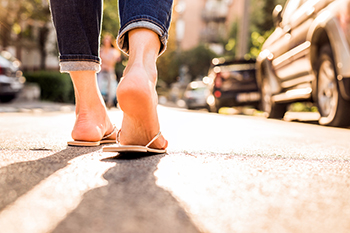Kirksville (660) 665-9000
December 2022
Talking About Falls Prevention

The reality of a senior being susceptible to enduring a fall or tumble is serious and nothing to take lightly. Often, as an individual gets older, they might be unwilling to admit the growing likelihood of this kind of occurrence. However, a caretaker or loved one is capable of making a senior aware of this risk by having a simple conversation. Initiating productive conversations with a senior about the reality of enduring a fall can help make the senior more aware of ways to prevent such an injury from happening. For example, having these discussions with seniors can perhaps encourage them to take better care of the health of their feet, making foot care a more important part of their life. After initiating this dialogue with a senior, they also might be more mindful of how they can increase their foot's strength. Contact a podiatrist today if you have any questions or concerns about falls prevention.
Preventing falls among the elderly is very important. If you are older and have fallen or fear that you are prone to falling, consult with Deborah Holte, DPM from Northeast Missouri Foot Clinic. Our doctor will assess your condition and provide you with quality advice and care.
Every 11 seconds, an elderly American is being treated in an emergency room for a fall related injury. Falls are the leading cause of head and hip injuries for those 65 and older. Due to decreases in strength, balance, senses, and lack of awareness, elderly persons are very susceptible to falling. Thankfully, there are a number of things older persons can do to prevent falls.
How to Prevent Falls
Some effective methods that older persons can do to prevent falls include:
- Enrolling in strength and balance exercise program to increase balance and strength
- Periodically having your sight and hearing checked
- Discuss any medications you have with a doctor to see if it increases the risk of falling
- Clearing the house of falling hazards and installing devices like grab bars and railings
- Utilizing a walker or cane
- Wearing shoes that provide good support and cushioning
- Talking to family members about falling and increasing awareness
Falling can be a traumatic and embarrassing experience for elderly persons; this can make them less willing to leave the house, and less willing to talk to someone about their fears of falling. Doing such things, however, will increase the likelihood of tripping or losing one’s balance. Knowing the causes of falling and how to prevent them is the best way to mitigate the risk of serious injury.
If you have any questions, please feel free to contact our office located in Kirksville, MO . We offer the newest diagnostic and treatment technologies for all your foot care needs.
Shoes or Genetics May Cause Hammertoe

All of the toes, except for the big toe, have three bony segments that are separated by joints. The foot condition that is known as hammertoe can cause the joints that are between the first and second segment to bend downward, and it generally affects the second and third toe. It is considered to be a deformity, and can be caused by genetic factors or from wearing shoes that do not fit correctly. These types of shoes typically do not have adequate room for the toes to move freely in and can change the shape of the foot. Many patients can experience pain in the ball of the foot, and difficulty in finding shoes that fit properly. Additionally, corns may develop on top of the toes as a result of friction that is caused by the toes constantly touching the top of the shoe. Hammertoe is easy to diagnose, and X-rays are often not necessary to take. Relief may come from performing specific stretches, and cushioned pads may be used on top of the corns. If you have developed hammertoe, please speak to a podiatrist who can diagnose and offer you correct treatment solutions, which may include surgery for permanent straightening.
Hammertoes can be a painful condition to live with. For more information, contact Deborah Holte, DPM of Northeast Missouri Foot Clinic. Our doctor will answer any of your foot- and ankle-related questions.
Hammertoe
Hammertoe is a foot deformity that occurs due to an imbalance in the muscles, tendons, or ligaments that normally hold the toe straight. It can be caused by the type of shoes you wear, your foot structure, trauma, and certain disease processes.
Symptoms
- Painful and/or difficult toe movement
- Swelling
- Joint stiffness
- Calluses/Corns
- Physical deformity
Risk Factors
- Age – The risk of hammertoe increases with age
- Sex – Women are more likely to have hammertoe compared to men
- Toe Length – You are more likely to develop hammertoe if your second toe is longer than your big toe
- Certain Diseases – Arthritis and diabetes may make you more likely to develop hammertoe
Treatment
If you have hammertoe, you should change into a more comfortable shoe that provides enough room for your toes. Exercises such as picking up marbles may strengthen and stretch your toe muscles. Nevertheless, it is important to seek assistance from a podiatrist in order to determine the severity of your hammertoe and see which treatment option will work best for you.
If you have any questions, please feel free to contact our office located in Kirksville, MO . We offer the newest diagnostic and treatment technologies for all your foot care needs.
Effective Prevention Techniques for Athlete’s Foot

Athlete’s foot is a foot condition that can be uncomfortable and unsightly. It is caused by a fungus that lives in warm environments such as public swimming pools, shower room floors, and locker rooms. The symptoms that often accompany this can include itchiness between the toes and on the bottom of the foot, and the skin can be white and soggy. Some people have cracked skin with this ailment, in addition to small blisters. Patients who have a weakened immune system may be prone to getting athlete’s foot, in addition to having poor foot hygiene. Some people have learned to avoid athlete’s foot by wearing appropriate shoes while in public places, and refraining from sharing towels, shoes, and socks. It may help to use foot powder inside the shoes, which may aid in prevention. If you have this foot condition, it is strongly suggested that you are under the care of a podiatrist who can prescribe medication for complete healing.
Athlete’s Foot
Athlete’s foot is often an uncomfortable condition to experience. Thankfully, podiatrists specialize in treating athlete’s foot and offer the best treatment options. If you have any questions about athlete’s foot, consult with Deborah Holte, DPM from Northeast Missouri Foot Clinic. Our doctor will assess your condition and provide you with quality treatment.
What Is Athlete’s Foot?
Tinea pedis, more commonly known as athlete’s foot, is a non-serious and common fungal infection of the foot. Athlete’s foot is contagious and can be contracted by touching someone who has it or infected surfaces. The most common places contaminated by it are public showers, locker rooms, and swimming pools. Once contracted, it grows on feet that are left inside moist, dark, and warm shoes and socks.
Prevention
The most effective ways to prevent athlete’s foot include:
- Thoroughly washing and drying feet
- Avoid going barefoot in locker rooms and public showers
- Using shower shoes in public showers
- Wearing socks that allow the feet to breathe
- Changing socks and shoes frequently if you sweat a lot
Symptoms
Athlete’s foot initially occurs as a rash between the toes. However, if left undiagnosed, it can spread to the sides and bottom of the feet, toenails, and if touched by hand, the hands themselves. Symptoms include:
- Redness
- Burning
- Itching
- Scaly and peeling skin
Diagnosis and Treatment
Diagnosis is quick and easy. Skin samples will be taken and either viewed under a microscope or sent to a lab for testing. Sometimes, a podiatrist can diagnose it based on simply looking at it. Once confirmed, treatment options include oral and topical antifungal medications.
If you have any questions, please feel free to contact our office located in Kirksville, MO . We offer the newest diagnostic and treatment technologies for all your foot care needs.
Plantar Warts Can Be Treated!
Pros and Cons of Wearing Flip-Flops

There are many differences of opinion concerning flip-flops and the feet. Despite the ease and choice of several designs and colors to choose from, wearing these types of shoes may have detrimental effects on the feet. Flip-flops are made of rubber material, with a thin piece separating the big toe from the other toes. They generally have little or no arch support, and the toes work harder than usual to keep the shoe on the foot. It is beneficial to wear flip-flops for a limited time, such as going to the beach or pool, followed by wearing a more supportive shoe at the end of the day. There are flip-flops that are made of sturdier materials, in addition to having a strap on the back. This may be helpful in preventing cracked heels from developing. Flip-flops can be fun to wear, and if you desire to do so, it is suggested that you confer with a podiatrist who can guide you toward the best type of this shoe to purchase.
Flip-flops are not always the best choice of footwear. If you have any concerns about your feet or ankles, contact Deborah Holte, DPM from Northeast Missouri Foot Clinic. Our doctor will assist you with all of your foot and ankle needs.
Flip-Flops and Feet
When the weather starts warming up, people enjoy wearing flip-flops. Flip-flops are comfortable, stylish, and easy to slip on and off; they're perfect for any summer beach goer. However, these shoes can cause harm to the feet.
How Can Flip-Flops Affect Me Long-Term?
- Ankle problems
- Hip problems
- Lower back problems
- Pain in the balls of the feet
- Problems with foot arches
- Changes in the way you walk
Are There Injuries Associated with Flip-Flops?
Yes. Since flip-flops are relatively weak and do not provide the same amount of support as sneakers, people who wear flip-flops regularly are more susceptible to injuries. On top of that, the open nature of the shoe makes your feet more prone to other problems, such as cuts and even infections. Common injuries and ailments include:
- Sprained ankles
- Blisters
- Infections
- Cuts and Scrapes
I like Wearing Flip-Flops. Are There Safe Alternatives?
When buying flip-flops, try to find ones that have sturdy soles and that are made of high-quality materials that will support for your feet. These flip-flops will cost more but will also last longer as a result.
If you have any questions please feel free to contact our office located in Kirksville, MO . We offer the newest diagnostic and treatment technologies for all your foot and ankle needs.





